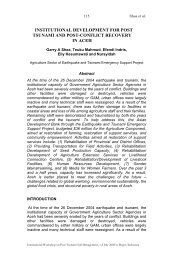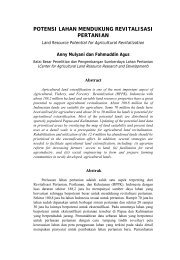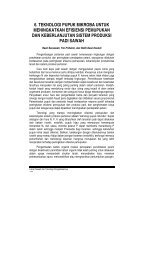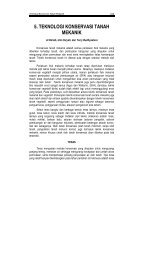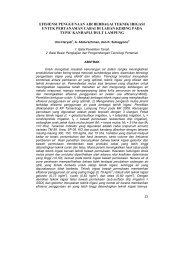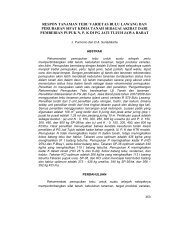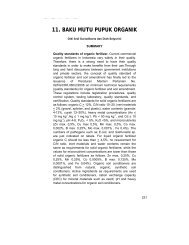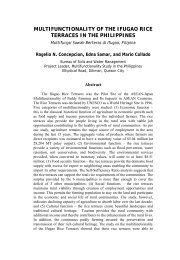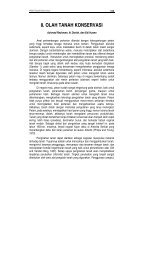Proceedings - Balai Penelitian Tanah
Proceedings - Balai Penelitian Tanah
Proceedings - Balai Penelitian Tanah
You also want an ePaper? Increase the reach of your titles
YUMPU automatically turns print PDFs into web optimized ePapers that Google loves.
INTRODUCTION<br />
52<br />
Rachman et al.<br />
A massive earthquake on December, 26 th 2004 followed by a tsunami<br />
in Aceh has altered the soil physical, chemical, and biological<br />
properties of soil in the affected areas. The tsunami sent not only<br />
seawater but also mud from the sea floor and coastline to as far as 3-<br />
5 km inland. As the water receded, the materials sank and capped<br />
the soil surface with mud and debris. Shofiyati et al., (2005), based on<br />
their estimation using Landsat ETM images, reported that the total<br />
area in Aceh inundated by seawater is 120.295 ha of which Aceh<br />
Barat district had the largest affected area (18.947 ha) followed by<br />
Aceh Utara and Lhokseumawe (18.235 ha), Pidie (14.837 ha), Aceh<br />
Jaya (13.206), Aceh Besar (12.893 ha) and the smallest is Aceh<br />
Singkil (1.462 ha).<br />
The seawater composed of salt, mainly in the form of NaCl. Other<br />
forms include a combination of basic cations (K, Ca, and Mg) and<br />
sulfate, bicarbonate, and chlorine anions. The seawater that<br />
inundated the agricultural land, in some areas lasted for several days,<br />
had a chance to infiltrate into the soil profile and increased the salinity<br />
of soil. Soil salinity is an important growth-limiting factor for most nonhalophytic<br />
plants. Salts inhibit plant growth by osmotic stress,<br />
nutritional imbalance, and specific ion toxicity (Cornillon and Palloix,<br />
1997; Gunes et al., 1996). High levels of sodium on the exchange<br />
complex as indicated by the ESP (exchangeable sodium percentage)<br />
value greater than 15 may deteriorate soil structure, which in turn<br />
reduce plant growth (Ben-Hur et al., 1998).<br />
This paper reports the changes in soil chemical properties that<br />
occurred in the 3 years that followed the 2004 tsunami in Aceh. The<br />
properties of the tsunami mud are discussed and the changes are<br />
chemical properties interpreted in relation to likely limitations to crop<br />
production.<br />
MATERIALS AND METHODS<br />
Tsunami muds were sampled on 26-29 January 2005. Samples were<br />
collected from two transects eg Darussalam and Lhok Nga to<br />
represent dry land and paddy field dominated agriculture, respectively.<br />
On each transect, 5 sampling positions were selected based on<br />
distances from shoreline. For Darussalam transect, the distance from<br />
shoreline for each sampling position were 1, 2.5, 3.5, 4, and 4.5 km,<br />
whilst for Lhok Nga transect were 1, 2, 3,5, 4, and 5 km. From each<br />
sampling position, 2 composite soil samples were removed to<br />
represent the top soil (0 – 10 cm soil depth) and sub soil (10 – 20 cm<br />
soil depth). Soil samples were analyzed at the soil laboratory of<br />
Indonesian Soils Research Institute in Bogor. Soil salinity was<br />
International Workshop on Post Tsunami Soil Management, 1-2 July 2008 in Bogor, Indonesia



